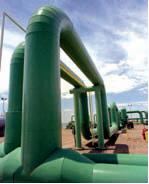 | ||
Hydrogen pipeline transport is a transportation of hydrogen through a pipe as part of the hydrogen infrastructure.
Contents
History
Economics
Hydrogen pipeline transport is used to transport hydrogen from the point of production or delivery to the point of demand. Although hydrogen pipeline transport is technologically mature, and the transport costs are similar to those of CNG, most hydrogen is produced in the place of demand, with an industrial production facility every 50 to 100 miles (80 to 161 km)
Piping
Hydrogen has problems with both hydrogen embrittlement and corrosion. Hydrogen has an active electron, and therefore behaves somewhat like a halogen. For this reason, hydrogen pipes have to resist corrosion. The problem is compounded because hydrogen can easily migrate into the crystal structure of most metals. For metal piping at pressures up to 7,000 psi (48 MPa), high-purity stainless steel piping with a maximum hardness of 80 HRB is preferred.
Composite pipes are assessed like:
Fiber-Reinforced Polymer pipelines (or FRP pipeline) and reinforced thermoplastic pipes are researched.
